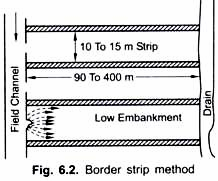Irrigation water is generally applied to crops by:
- Flooding on the field surface
- Applying beneath the soil surface
- Spraying under pressure
- Applying in drops in the crop root zone
The application method must ensure a uniform distribution of water along the cropped field as well as in the root zone of the crop with high application efficiency. The ratio of water stored in the root zone to that delivered to the field should be maximum. There should be minimum or no wastage of water either through surface run-off or deep percolation below the root zone of a crop.
Several water application methods are practised to suit different soil types, water supply and its quantity, the topography of the land, crops to be irrigated and costs.
Surface Application Methods:
- In this method, water is applied to the crop by flooding it on the soil surface.
- This method requires proper land grading for the flow of water over the land surface.
- More than 95% of the irrigated area in India is under surface irrigation.
- Merits:
- It is simple in layout and operation.
- The amount of manual labour required is minimum.
- It does not obstruct the use of machinery for land preparation, cultivation, harvesting, etc.
- Demerits:
- The overall irrigation efficiency is low. The worldwide average irrigation in canal command areas shows an overall efficiency of as low as 28%.
- It may result in water=logging and soil salinization besides the huge amount of water losses.
-
Surface Irrigation methods may be broadly classified as:
- Border Method:
- Borders are formed by dividing the field into a number of strips which are separated by ridges.
- The strips are generally levelled along the width but may or may not have slope along the length.
- An irrigation channel runs along the upper end of the borders.
- The water is diverted from the channel into the strips. The water flows slowly towards the lower end, wetting the soil as it advances. Extra water is generally removed from the strip by means of a collecting drain. It is provided at the other end.
- This method is suitable in the fields where the soil is sufficiently capable of absorbing the water.
- Furrow Method:
- Furrow irrigation is adaptable to a great variation in slope, crops and topography.
- When the crops are grown and planted in rows this method is the best suited. In this method, unlike flooding, only a part of the field is wetted. The area wetted varies from 1/2 to 1/5 of total area over which crops are grown.
- Close growing crops, on slopes and soils that develop crust after being wet, may be irrigated with small furrows which are called corrugations or rills.
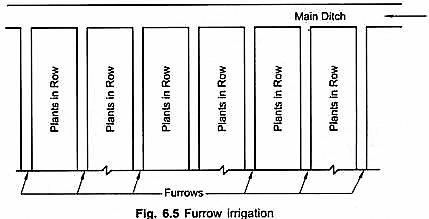 Source
Source-
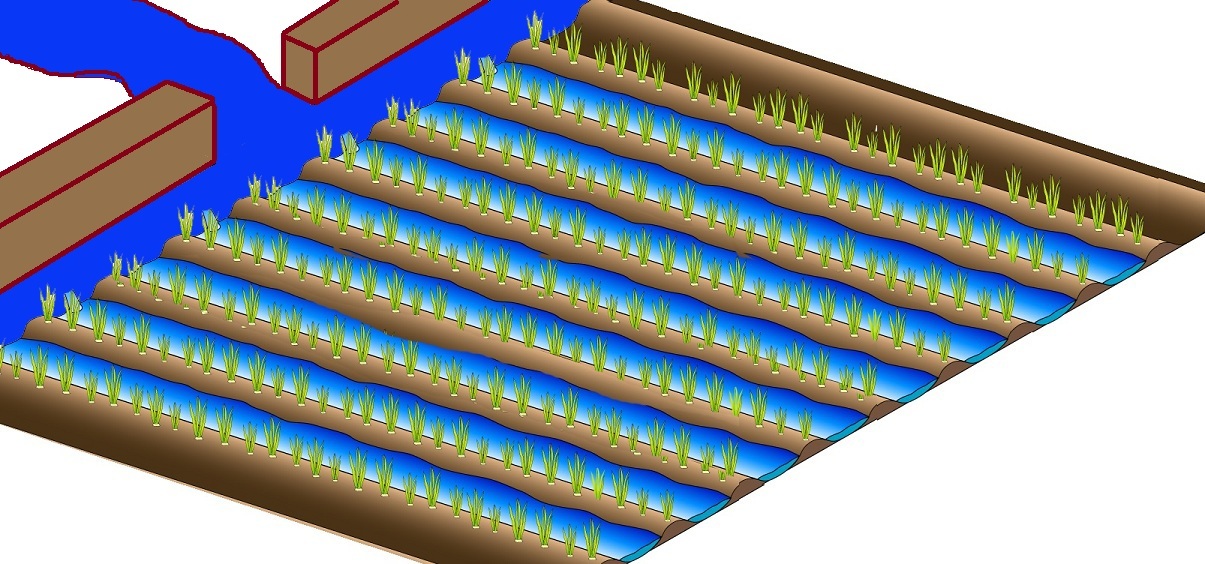
Source
- The main design parameters of furrows are
- Longitudinal slope
- Inflow stream design
- Furrow spacing:
- Furrow spacing should be such that the lateral water movement of the moisture wets the ridges by the time irrigation is complete. The lateral movement from the furrows depends on the soil type.
- Furrow spacing is determined by agronomic requirements of row-to-row spacing and machinery to be used for planting and cultivation.
- Furrow length: Longer furrows = more percolation and less run-off
- Benefits of this method:
- In this method plants in their early tender age are not damaged by the flow of water.
- The land between the rows of plants is utilised to construct furrows, therefore useful irrigable land is not wasted.
- As the area wetted is just 1/2 to 1/5 of the cropped area of the field, puddling and crusting of the soil is minimum.
- Border Method:
-
-
- Check basin:
- It consists of running water into relatively level plots surrounded by small ridges.
- The length of the plot is generally less than 3 times the width.
- The main and lateral channels irrigate The main channel is aligned along the upper end of the field and checks are made on the either side of the lateral channels.
-
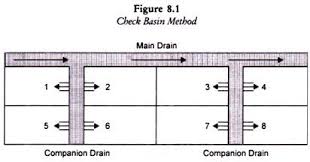
Source
-

Source
- The check basins are especially suitable for heavy soils with low infiltration rate or highly permeable sandy soils.
- The key to attaining high irrigation efficiency in the design of the check basin is to spread water over the entire basin as rapidly as possible.
- Therefore, the use of large inflow stream reduces water spread time over the basin.
- Check basin:
-
Sprinkler and Micro-Sprinkler Application:
- Sprinklers:
- This system sprinkles water in a manner similar to rainfall so that run-off and deep percolation losses are avoided and the uniformity of application is quite high.
- The system consists of sprinkler heads or nozzles, which are mounted on risers in lateral lines taken from the main line, which is further connected to a pumping unit.
-
 Source
Source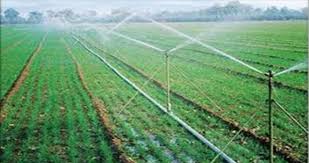
Source
- This system of irrigation is suitable when:
- The soil is too porous for good distribution by surface irrigation.
- The fields have an uneven surface.
- The soil is easily erodable.
- The water supply is just sufficient for crop growth.
- Merits:
- Sprinklers can be used on all soil types of any topography.
- It entails increased irrigation frequency which has a positive effect on crop yield.
- In this method, a water saving of 30% to 50% is reported in comparison to the surface method of irrigation
- Thus by introducing sprinklers, an additional area ~ up to 50% can be brought under irrigation besides increased crop yields
- The overall efficiency of the system is above 80% and no land is wasted on making bunds and channels, and about 40-50% of saving in labour as compared to surface irrigation.
- Only 2 to 5% water is lost through evaporation.
- Demerits:
- Expensive
- Requires continuous maintenance and skill for installation and operation
- The high energy requirement for operation as sprinklers operate at water pressure ranging from 1 to 10 kg/sq cm.
- Wind interferes with the distribution pattern. It reduces the spreading rate and in turn the efficiency. Under high temperatures and strong winds heavy evaporation loss takes place thereby offsetting the saving in water.
- Micro-sprinklers:
- It sprinkles around the root zone with small sprinklers that work under low pressure.
- In this method, water is applied only to the root zone area unlike to the entire field as in the case of sprinkler irrigation method.
- This method is highly suitable for orchard crops and vegetable crops.
Drip Application
- In this method, the application of water is precise but slow as discrete drops, continuous drops, tiny streams or miniature sprays through mechanical devices, called emitters or applicators located at selected points along water delivery lines.
- This is useful in areas with water scarcity and salt problems.
- Drip irrigation system consists of main pipe, sub-mains, lateral valves, drippers or emitters, a riser valve, vacuum breakers, pressure gauges, water metres, filters, fertiliser tanks etc.
- These are designed to supply water at desired rates (1 to 10 litres/hour) directly to the soil.
- Low pressures ranging from 0.35 to kg/sq cm are sufficient for drip system
-

Source
- Merits:
- Water saving
- Enhanced plant growth and yield
- Saving of labour and energy
- More suited to poor soils
- Controls weed growth
- Easy operations
- Fertilisers or other chemical amendments can be efficiently applied to individual or separate plants using drip irrigation.
- Flexibility in operation
- No soil erosion
- Requires less land preparation
- Minimum disease and pest problems
- This method has been found to be of great value in reclaiming and developing desert and arid areas.
- Demerits:
- Expensive
- Technical Limitations
- Requirement of high skills for design, installation and operation
